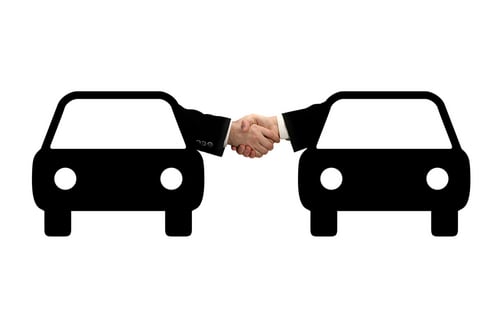
The other day I stumbled upon a headline on The Detroit News website that caught my attention. It said, “Automaking rivals join forces as rules get tighter.” Rivals teaming up? I had to read further.
The article actually focuses on how rival automakers are coming together “to share costs and brainpower” to help meet new fuel efficiency and environmental requirements. That could be risky, I thought. Aren’t they throwing their competitive advantage out the window?

The article goes on to explain that collaborations like these are the new normal. If our common goal in this world is a vehicle with unimaginable fuel efficiency and each automaker has a piece of the puzzle, I guess it makes sense to join forces and complete the puzzle. They all win equally. Sort of.
See, the automobile makers are smart. They’ve done their research. They understand their consumers and what makes them buy. The article says that consumers don’t care who invented a specific technology when it comes to components under the hood. The current trend with consumers is that they “make buying decisions based on design and technology, a shift from consumer trends in previous generations in which power and performance were the center of attention.”
They’ve realized their competitive edge isn’t necessarily with how quickly their car can accelerate from zero to 60 miles per hour or whether it can go 30 or 35 miles per gallon. It’s the design—the overall look and feel—and the technology that will make them outsell their competition. That’s the difference.
So let me test this theory with myself. When I was shopping for a new vehicle back in 2010, I wasn’t all that concerned with how much power it had or how fast it could go. I cared a little about the fuel efficiency, but I get 23 miles per gallon with the car I bought then, so obviously I didn’t care that much. Actually when I was shopping I wanted a vehicle that looked good with satellite radio and a plug for my iPod. I bought the one that was equipped with those things.
Hmm... Theory proven.
OK, so how can automakers differentiate themselves from their competitors? Three words: engineering design software.
If it’s the design that will sell a car, then good software is key. Picture a beautiful four-door curvaceous sedan. Each of its pieces—the hood, the doors, the trunk—so perfectly interlocking that when you’re inside with the doors shut, it’s pure silence. Peace and quiet. I bet consumers would buy that.
With 3DCS Variation Analysis, the hood, doors and trunk among other components could be manufactured to the tiniest tolerances, allowing for a smooth, high-end look and a perfect fitting. Yes, consumers would buy that.
Let’s consider DCS’ visualization and rendering services. If the design and look is so important to buyers, why not get their input before a dime is spent on manufacturing the parts. DCS designers can add realistic images to designs so manufacturers could share them with their customers to gauge how they feel before spending the time and money to actually produce the automobile. With 3D CAD analysis software like 3DCS, a designer also can add variation to these images, making sure that once the product is actually made, manufacturing variation will not negatively affect the product's perceived quality.
Now, how about quality data management? If part of the reason why manufacturers are working with rivals is to save money, they should know that quality data management software can help them achieve that goal as well. QDM produces customized reports that help manufacturers identify the root cause of problems within the manufacturing process—ultimately reducing down time, scrap and warranty claims.
Well, the secret’s out! Design and technology sells vehicles … and 3DCS software can put manufacturers in a position to sell even more cars and trucks. And speaking of new cars … it’s been a few years for me, maybe it’s time to cruise the dealership lot.
These Stories on CATIA
No Comments Yet
Let us know what you think